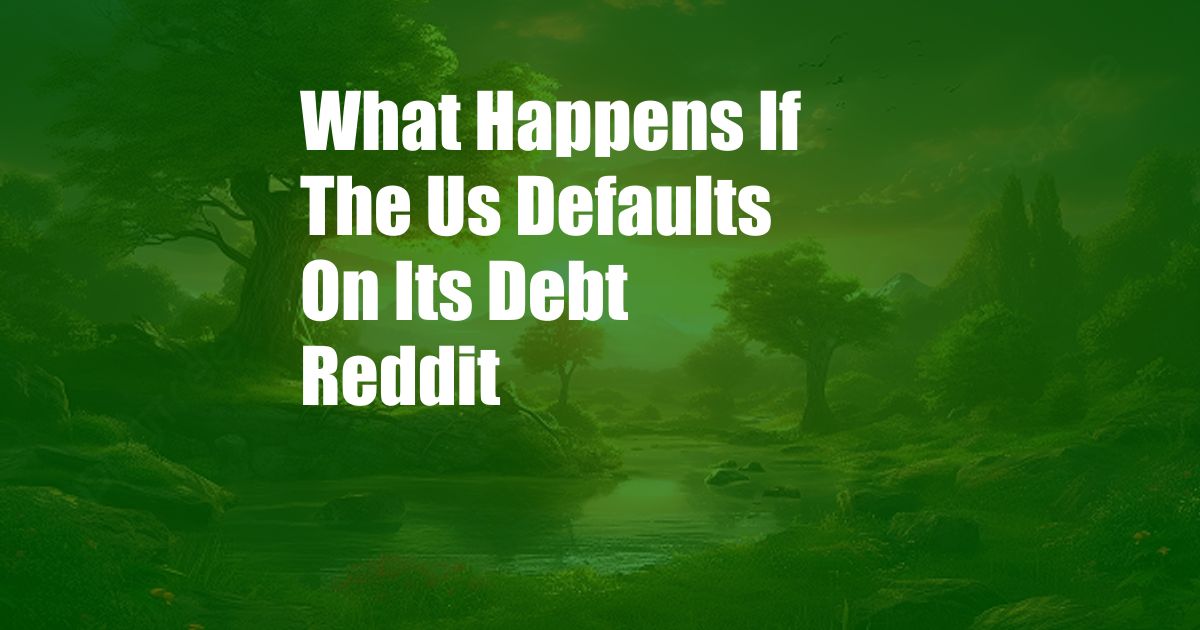
What Happens if the US Defaults on Its Debt?
Imagine a world where the United States, the world’s largest economy, fails to honor its financial obligations. Defaulting on its debt would trigger a catastrophic chain reaction, sending shockwaves through global markets and potentially plunging the world into a deep recession.
The US debt ceiling, a legal limit set by Congress on the amount of money the government can borrow, has been a topic of heated debate for decades. While the Treasury Department has employed various accounting measures to avoid breaching the debt ceiling, the potential consequences of failing to raise it are dire.
Consequences of a US Debt Default
Economic Catastrophe
A US debt default would shatter confidence in the global financial system. Investors would lose faith in the dollar’s stability, leading to a sharp decline in its value. This would make it more expensive for the US to import goods and services, driving up inflation and straining businesses.
Moreover, a default could trigger a sell-off in US Treasury bonds, the cornerstone of the global financial system. This would increase interest rates and make it more difficult for businesses and individuals to borrow money, resulting in a slowdown in economic growth and a drop in asset values.
Social Unrest
The economic turmoil caused by a debt default could lead to social unrest. With businesses closing and unemployment rising, people would struggle to make ends meet. This could foster an environment of frustration and despair, leading to protests and even violence.
Trust in government would erode as citizens witness the consequences of its financial mismanagement. The stability of society would be threatened as people lose confidence in the ability of their leaders to provide for their well-being.
International Relations
A US debt default would have significant implications for international relations. The country’s status as a global superpower and the world’s reserve currency would be tarnished. Other countries would be reluctant to enter into agreements with the US, fearing a repeat of the default.
The United States’ ability to project power and influence on the world stage would be diminished. Its credibility as a reliable partner and guarantor of international security would be eroded.
Latest News and Developments
In recent years, the debt ceiling debate has intensified. Political gridlock in Congress has made it increasingly difficult to raise the limit. In 2011, the standoff between Republicans and Democrats resulted in the US credit rating being downgraded for the first time in history.
In October 2021, the US government once again reached its debt ceiling. The Treasury Department suspended sales of certain government securities and implemented extraordinary measures to avoid a default. However, these measures are temporary, and the government will need to find a solution before March 2023, or the country will face the risk of default.
Tips and Expert Advice
To mitigate the catastrophic consequences of a US debt default, it is imperative that policymakers take the following steps:
- Raise the debt ceiling: Congress must raise the debt ceiling before the Treasury Department exhausts its extraordinary measures.
- Reduce the deficit: The US government needs to reduce its annual budget deficit to make its debt more sustainable in the long term.
- Economic growth: Promoting economic growth will increase tax revenues and reduce the government’s reliance on borrowing.
Experts from the International Monetary Fund (IMF) and credit rating agencies have consistently warned of the severe risks associated with a US debt default. They urge policymakers to act responsibly and avoid a catastrophe that would harm not only the United States but the global economy as a whole.
FAQs
Q: What would happen if the US defaulted on its debt?
A: A US debt default would trigger an economic catastrophe, social unrest, and damage US credibility on the world stage.
Q: How can a debt default be avoided?
A: By raising the debt ceiling, reducing the deficit, and promoting economic growth.
Q: Why is the debt ceiling limit important?
A: The debt ceiling is a legal limit set by Congress on how much the government can borrow. Breaching the limit would result in a default.
Q: What is the current status of the US debt ceiling?
A: In October 2021, the US government reached its debt ceiling. The Treasury Department is currently using extraordinary measures to avoid a default.
Conclusion
The consequences of a US debt default are too dire to contemplate. It is imperative that policymakers take the necessary steps to avoid this catastrophic scenario. The economic, social, and international repercussions would be profound and long-lasting.
As citizens, we can hold our representatives accountable for managing the nation’s finances responsibly. By understanding the potential consequences of a debt default, we can demand that our leaders prioritize the long-term well-being of our country and the stability of the global economy.
Call to Action:
Are you concerned about the potential consequences of a US debt default? Share your thoughts and join the conversation online!